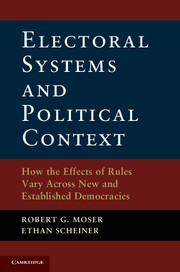 Electoral Systems and Political Context
Electoral Systems and Political Context Published online by Cambridge University Press: 05 November 2012
In this chapter, we turn our attention away from strategic defection by voters and elites and the number of parties under plurality rules to focus on the types of people who win office in democratic elections. More specifically, we explore how political context conditions the impact of electoral rules on the election of women to legislative office.
The election of women to public office is inherently important. Intuitively, female representation offers symbolic benefits for gender equality (see Phillips 1995), and there is evidence that female legislators behave differently from their male counterparts (Mansbridge 1999; Bratton and Ray 2002). It is therefore noteworthy that electoral systems are important in shaping the degree to which women win elected office. Significant research indicates that larger shares of women gain office under closed-list proportional representation rules than in single-member districts, but this finding is more consistent in consolidated democracies than in new ones.
The literature implicitly highlights two features of PR that especially help women’s representation. First, the closed-list party vote in many PR systems would appear to help women over the more candidate-centered balloting under SMDs: compared with the process by which candidates are nominated for SMD races, national party leaders appear more inclined to nominate women, so closed party lists and centralized party nomination processes are seen as more conducive to women’s representation (Norris 1993; Valdini 2005, 2006). Moreover, some voters may not wish to vote for a woman under SMD rules when they cast their ballots for individual candidates, but see no problem with casting a ballot for a list that includes women under PR where they vote for a party. Second, the higher district magnitudes of PR systems also appear to offer women a better shot at election than single-member districts (especially FPTP) by lowering the effective threshold (i.e., the share of the vote) necessary for election.
To save this book to your Kindle, first ensure [email protected] is added to your Approved Personal Document E-mail List under your Personal Document Settings on the Manage Your Content and Devices page of your Amazon account. Then enter the ‘name’ part of your Kindle email address below. Find out more about saving to your Kindle.
Note you can select to save to either the @free.kindle.com or @kindle.com variations. ‘@free.kindle.com’ emails are free but can only be saved to your device when it is connected to wi-fi. ‘@kindle.com’ emails can be delivered even when you are not connected to wi-fi, but note that service fees apply.
Find out more about the Kindle Personal Document Service.
To save content items to your account, please confirm that you agree to abide by our usage policies. If this is the first time you use this feature, you will be asked to authorise Cambridge Core to connect with your account. Find out more about saving content to Dropbox.
To save content items to your account, please confirm that you agree to abide by our usage policies. If this is the first time you use this feature, you will be asked to authorise Cambridge Core to connect with your account. Find out more about saving content to Google Drive.